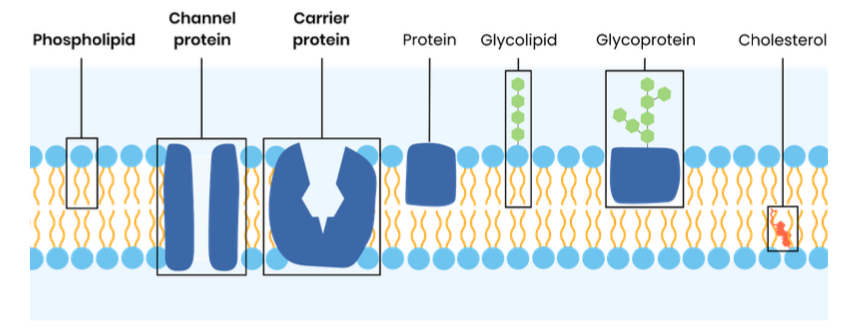2.3 transport across cell membranes
1/20
Earn XP
Description and Tags
Name | Mastery | Learn | Test | Matching | Spaced |
|---|
No study sessions yet.
21 Terms
describe the fluid mosaic model of membrane structures
molecules are free to move laterally in phospholipid bilayer
many components - phospholipids, proteins, glycoproteins and glycolipids
describe the arrangement of the components of a cell membrane (6)
phospholipids form a bilayer - fatty acid tails face inwards, phosphate heads face outwards
intrinsic/integral proteins span bilayer e.g. channel and carrier proteins
extrinsic/peripheral proteins on surface of membrane
glycolipids found on exterior surface
glycoproteins found on exterior surface
cholesterol bonds to phospholipid hydrophobic fatty acids tails
diagram of cell membrane

explain the arrangement of phospholipids in a cell membrane
bilayer with water present on each side
hydrophobic fatty acid tails repelled from water so point away from water/to interior
hydrophilic phosphate heads attracted to water so point to water
role of cholesterol
restricts movement of other molecules making up membrane
decreases fluidity / increases rigidity
suggest how cell membranes are adapated for other functions
phospholipid bilayer is fluid - membrane can bend for vesicle formation / phagocytosis
glycoproteins/glycolipids act as receptors / antigens involved in cell signalling / recognition
explain limitations imposed by the nature of phospholipid bilayer
restricts movement of water soluble (polar) and larger substances
due to hydrophobic fatty acid tails in interior of bilayer
what are the way substances can move in the cell surface membrane
diffusion - small substances down a conc gradient
osmosis - water, down a water potential gradient
active transport - against a conc gradient via protein carrier using ATP
facilitated diffusion - polar down a conc gradient via channel protein
co transport -2 different substances using carrier protein
describe how movement across membranes occurs by simple diffusion
lipid soluble (non-polar) or very small substances
move from an area of higher concentration to an area of lower concentration down a concentration gradient
across phospholipid bilayer
passive - doesn’t require ATP
describe movement across membranes by facilitated diffusion
water soluble (polar) / slightly larger substances
move down a concentration gradient across
through specific channel/carrier proteins extrinsic
passive
what feature of a protein determines which substances move
shape/charge of protein
explain role of channel proteins
facilitate diffusion of water soluble substances
hydrophobic pore filled with water
may be gated - can open/close
explain the role of carrier proteins
facilities diffusion of slightly larger substances
complementary substances attaches to binding site
protein changes shape to transport substance
describe movement across membranes by osmosis
water diffuses/moves
from an area of high to low water potential / down a water potential gradient
through a partially permeable membrane
passive
describe movement across membranes by active transport
substances move from an area of lower to higher concentration / against a concentration gradient
requiring hydrolysis of ATP and specific carrier proteins
describe the role of carrier proteins and the importance of the hydrolysis of ATP in active transport
complementary substance binds to specific carrier protein
ATP binds, hydrolysed into ADP + Pi releasing energy
carrier protein changes shape releasing substance on side of higher concentration
Pi released - protein returns to original shape
describe movement across membranes by co transport
two different substances bind to and move simultaneously via a co transporter protein
movement of one substance against its concentration gradient is often couple with the movement of another down its concentration gradient
example of co transport
absorption of sodium ions and glucose by cells lining the mammalian ileum
co transport of sodium ions and glucose
Na+ actively transported from epithelial cells to blood, establishing a concentration gradient of Na+
Na+ enters epithelial cell down its concentration gradient with glucose against its concentration gradient, via a co transporter protein
glucose moves down a concentration gradient into blood via facilitated diffusion
factors that affect rate of movement across cell membranes (5)
increasing surface area of membrane increases rate of movement across membranes
increasing number of channel/carrier proteins increase rate of facilitated diffusion/ active transport
increasing concentration gradient increases rate of simple / facilitated diffusion and osmosis
increasing concentration gradient increases rate of facilitated diffusion until number of channel/carrier proteins becomes a limiting factor as all in use
increasing water potential gradient increases rate of osmosis
explain adaptations of some specialised cells in relation to rate of transport
membrane folded e.g. microvilli in ileum increases surface area
more protein channels/carriers for facilitated diffusion
large number of mitochondria - makes more ATP by aerobic respiration for active transport